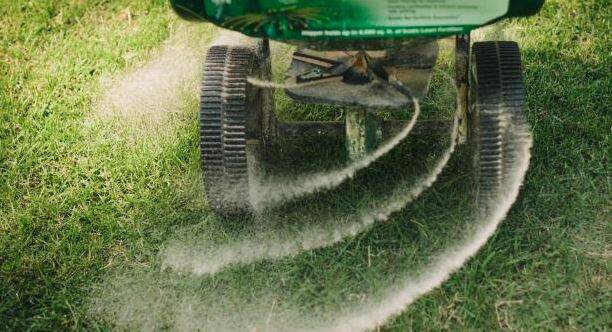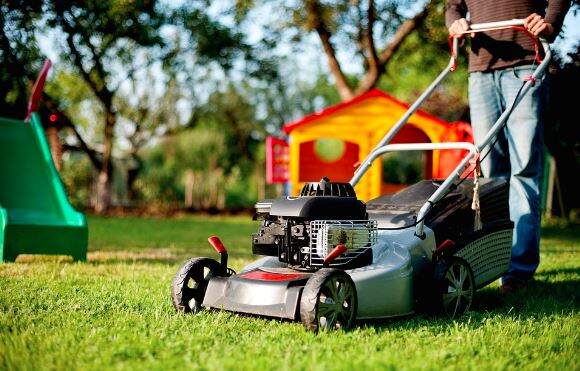
One must provide proper attention and care to have a lush, green, and healthy lawn. Fertilizing is one of the routine practices that promote the growth and vibrancy of a lawn. However, there are some specific scenarios when not to apply lawn fertilizer.
It’s not recommended to apply lawn fertilization when heavy rain is forecasted, temperatures are extreme, the lawn is infested with weeds and pests, the soil conditions are poor, during drought seasons, when soil testing indicates no, before lawn mowing, or when the lawn has been recently seeded.
In the rest of this article, I’ll dive into these situations to help you understand when to skip the fertilizer application process and consider alternative approaches. I’ll also provide helpful tips to guide you along the way. Enjoy the read!
1. When Heavy Rain Is in the Forecast
Whether it’s a lawn, farm, or garden, it’s not ideal to apply fertilizer just before the onset of heavy rains.
Why? You may wonder.
This is because the rain can wash away the nutrients during runoff. Besides rendering your efforts ineffective, washed away fertilizer can cause harm to water bodies and aqualife.
As such, checking your local weather forecast before applying fertilizer to your turf is essential.
If rains are not expected in at least 24 to 48 hours, you can be assured that your grass will get a chance to absorb the nutrients properly.
Find Out: What Temperature Is Too Cold to Fertilize Lawn Areas?
2. When the Temperatures Are Extreme
It’s ill-advised to apply fertilizer in the peak of summer or when there’s a cold burst of wind, as this can harm the grass instead of nourishing it.
When you fertilize your lawn during high temperatures, the fertilizer releases nutrients to the soil too quickly, leading to burnouts that damage the turfgrass.
Similarly, fertilizing grass in freezing cold weather results in the nutrients getting locked in the ice, thus hindering absorption.
It’s best to fertilize your lawn when the temperatures range from 15°C to 27°C (59 to 80.6℉). Fertilizing your grass within this temperature range has the following benefits:
- A vibrant and lush green appearance
- Healthy growth
- Stronger roots
- Excellent resistance to pests and diseases
- Balanced nutrient uptake
- High stress tolerance
3. During Drought Conditions

Converse to rainy weather, you are discouraged from applying lawn fertilizer when the soil is dry. This is because dry soil can stress the grass, compromising its ability to absorb nutrients.
Fertilizing in such conditions can lead to an imbalance in nutrient uptake, potentially harming the turf. Consider waiting until the drought has subsided and the soil has gained moisture before applying fertilizer to your lawn.
4. Newly Seeded or Sodded Lawns
If you’ve recently seeded your lawn, you must avoid applying fertilizers, or the nutrients can damage the new grass seedlings.
It’s crucial to wait until new grass has established its roots well before fertilizing, usually after the first mowing or when the grass blades reach 3 inches (7.62 cm) tall.
With a robust root system, the turfgrass can comfortably tolerate the nutrients.
5. During Weed or Pest Infestation
To avoid worsening your lawn problems, resist fertilizing when there are weeds or pests.
Weeds often thrive on the same nutrients that your turfgrass needs. This means that you can boost weed growth by applying fertilizer.
On the other hand, the same nutrients can exacerbate pest infestation since the pests can get attracted to the increased nutrient levels.
In such a case, it is essential to prioritize the control of weeds and pests before applying fertilizer to your lawn. Here are some suggestions if you’re facing this problem:
- Identify the weeds and pests: Identify the specific weeds and pests to choose the most effective control methods.
- Remove weeds manually: Hand-pull or use a weeding tool to remove visible weeds from the lawn. However, this method is only practical for isolated and large weeds like creeping charlie.
- Use herbicides: Apply selective herbicides such as Glyphosate or Roundup For Lawns1 to target weeds without harming your grass. Ensure to follow instructions carefully. Alternatively, consider spot treatments if the weed infestation is not widespread.
- Control pests: Identify the pests affecting your lawn and use appropriate pest control methods like insecticides. You can also use biological control such as controlling skunks from digging up the lawn.
- Overseed the lawn: After controlling weeds and pests, overseed the lawn with a suitable grass seed. This fills in bare spots and promotes a thicker, healthier lawn.
- Aerate the soil: Lawn aeration improves drainage and allows nutrients to penetrate the root zone more effectively.
6. When Soil Testing Indicates No Need
Soil testing is the most surefire way of determining if your lawn needs additional nutrients. After analyzing the nutrient levels, you can tailor the fertilizer application accordingly.
It’s not advisable to apply additional fertilizer when the soil test indicates sufficient nutrients, or you could potentially harm your lawn.
Over-fertilizing can lead to many problems, such as nutrient runoff, grass burns, and environmental damage.
Also, if your soil test results require increasing nutrient levels, you must be careful not to apply extra fertilizer while expecting to speed up the greening process. On the contrary, you risk ruining your lawn.
7. Before Lawn Mowing
For proper absorption of nutrients, mowing your lawn beforehand is crucial. Applying lawn fertilizer before trimming the tall grass blades isn’t recommended.
Also, you must be careful not to apply fertilizer immediately after mowing, as the grass is still growing under stress.
It is best to give the turf a few days (about 7 days) to recover for proper nutrient absorption.
Best Practices for Fertilizer Application
For optimal results, fertilizing your lawn requires that you adhere to several best practices. Here are tips to help nourish your lawn effectively:
1. Conduct a Soil Test
First and foremost, it’s essential to determine the nutrient composition of your soil. Identifying your lawn’s specific mineral deficiencies or excesses will help you tailor your fertilizer application to suit the lawn’s most precise needs.
Soil testing will also save your pocket and energy since you’ll apply only the required amount of fertilizer to your lawn.
Some of the things you should test for include:
- Moisture
- pH
- Aeration
- Sulfate content
- Dissolved salts
- Electrical sensitivity
2. Choose the Right Fertilizer
All fertilizers have varying chemical compositions, typically made up of Nitrogen (N), Phosphorus (P), Potassium (K), and other micronutrients. For this reason, it would be wise to choose a formulation that aligns with the needs of your lawn.
For instance, if your soil testing results indicate a deficiency in nitrogen, which promotes lush, green growth, consider choosing a nitrogen-rich fertilizer.
3. Follow Recommended Application Rates
As we mentioned earlier, over-fertilizing is detrimental to your lawn, as it can lead to nutrient runoff, soil damage, and environmental harm. Meanwhile, under-fertilization is discouraged since it may limit the chances of a flourishing lawn.
It is essential to follow the instructions on the fertilizer packaging as they are carefully formulated to provide the necessary nutrients. Also, consider using a calibrated spreader for even distribution.
4. Consider Slow-Release Fertilizer
While traditional fertilizers release nutrients quickly and rapidly affect growth for a limited time, slow-release fertilizers provide a more gradual and sustained nutrient release. Besides promoting long-term health, this also reduces the risk of nutrient runoff.
Slow-release fertilizers are also available in granular and liquid forms, thus making the application process more flexible.
5. Apply Fertilizer at the Right Time
Timing plays a crucial role in the success of fertilizer application.
Generally, early spring and fall are the most timely seasons to fertilize your lawn, as grass tends to be actively growing during these periods.
Alternative Practices for Lawn Maintenance
Adding commercial fertilizer isn’t the only method of adding nutrients to your lawn. Some alternative approaches include:
1. Composting
Compost is a highly regarded source of organic matter, thanks to its ability to promote microbial activity in the soil. Besides enriching it with nutrients, compost manure improves soil structure, aeration, and water retention. You can use items such as kitchen scraps, yard waste, and plant remains to make your compost.
2. Grasscycling
After mowing your lawn, allow the grass clippings to decompose naturally on the lawn – they are an excellent nitrogen source. This practice, known as grasscycling, is essential in reducing the need for external fertilizers and enhancing soil fertility.
While conducting it, ensure the clippings are evenly distributed across the lawn to avoid lumps.
3. Use Clover as a Natural Fertilizer
Incorporating clover croppings into your lawn mix is another alternative to commercial fertilizer. Clovers are rich in nitrogen and naturally enrich the soil with this nutrient, acting as mulch, suppressing weed growth, and providing habitat for beneficial insects.
4. Bio-Stimulants
Bio-stimulants are substances that improve the soil’s ability to absorb nutrients and retain them. They enhance soil structure and microbial activity, thus increasing nutrient efficiency and reducing the need for excessive application of fertilizers.
5. Alfalfa Meal
Alfalfa meal is a natural fertilizer that enriches the soil with the three major nutrients and some trace elements. Being such an excellent choice for balanced nutrition, you should consider applying alfalfa meal to your lawn for steady and sustained growth.
6. Coffee Grounds
Ground coffee beans act as a fantastic source of nitrogen, which you can repurpose to enrich a nitrogen-deficient lawn. You can mix used coffee grounds with the soil or sprinkle them directly onto your lawn.
They also attract earthworms, which are beneficial to your turf.
Bottomline
As much as fertilization is a crucial component of proper lawn care, knowing when not to apply lawn fertilizer is paramount. This knowledge will save you from unnecessary expenses while protecting the environment and keeping your lawn healthy.
By considering weather conditions, soil and plant health, and the state of your lawn, you can apply fertilizer without harming the lawn or the environment.





